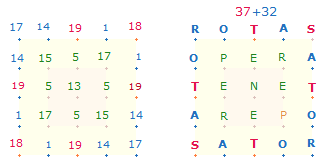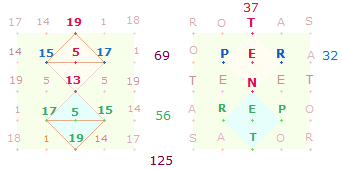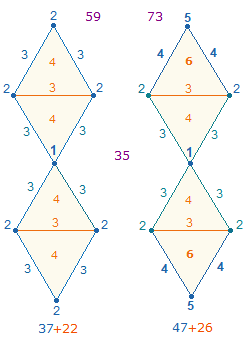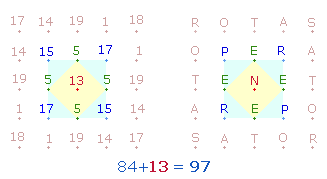gematric
calculator
The
Saviour's Smile in Eclogue 4
III. The
last sentence (62-63)
a) Principles of Interpretation
b) Contextual and Gematric Analysis
1.
The
true poet strives for truth with poetical means. Poetical truth can mean
everything that illuminates human dignity, everything that raises human
existence beyond the visible world of the senses and materialism. The
truthfulness of the poet must not be doubted. What he has to say must be
regarded with deep respect. The literary interpreter must not presume to be
wiser than the poet, he must beware of standing above the poet's consciousness
and self-knowledge.
2.
There
is no alternative to truth and truthfulness. The interpreter should constrict
himself to finding out and describing what the poet considers to be true. And
he must concede that he does not know everything about the poet's background of
knowledge and VISIONS.
3.
As to
Vergil's eclogue 4 there is a conincidence of his prediction of a SAVIOUR child
and the factual birth of CHRIST, eternal son of the eternal father, "CAELO
DIMITTITUR ALTO" (l.7). For those who believe in Jesus Christ there can be
no doubt that Virgil's vision was brought about by divine providence. In fact, human history is also a planful history of divine salvation,
so secular history was prepared and gradually led towards the advent of the
heavenly SAVIOUR. Vergil will have drawn on common notions and knowledge, but
also been inspired by personal mystical experience.
4.
By
means of the VESTA-Cult the initiated had a clear notion of the one GOD in
THREE PERSONS. This notion and the providential development of a close
interrelationship between letters and numbers – leading to gematrical
constructions – enabled the poets to express all spiritual meaning on a high METAPHORICAL level by making methodical use of the world of MYTHOLOGY, of symoblism and imagery. For
Vergil MYTHOLOGY fulfils the same function as the PROPHESIES of the BIBLE. Mythological
persons and stories have had their intrinsic value, but gain their ultimate
meaning in their metaphorical transformation and orientation towards the grand
New Order of DIVINE SALVATION. In the face of the the poet's immense gematric
efforts subservient MYTHOLOGY itself is CRUSHED to DUST.
5.
One
aspect of gematric construction is that words belonging together are chosen in
such way as to be an integral part of other constructional aspects.
6.
In
this sense the last sentence of eclogue 4 will be interpreted. It will be shown
that Vergil modelled his gematric construction on aspects of the SATOR-Square.
b) Contextual and Gematric Analysis
Incipe,
parve puer, RISU cognoscere matrem;
matri
longa decem tulerunt fastidia menses.
Incipe,
parve puer:
Begin, little boy,
to recognise your mother with a smile:
Ten months caused
your mother long inconveniences.
Begin,
little boy:
QUI NON RISERE PARENTI,
NEC DEUS HUNC MENSA DEA NEC
DIGNATA CUBILI EST.
Those who have not
smiled at their parent:
Neither a GOD has
considered him worthy of his table nor a GODDESS of her bed.
1.
The relation between the Saviour Child and
his mother is already introduced in lines 8-10 when LUCINA, the goddess of
birth delivery, is implored for help. In line 8 the KEYWORD PUERO occurs for the
first time.
Between this first mention of relationship and its
emphatic conclusion in the last four lines there is gradual development:
·
11-17: Preview of the Child's glorious future.
·
18-25: The Child is addressed with PUER. He is told what miraculous signs of the new
Golden Age will happen during the first days of his life.
·
26-36: The text continues addressing the boy,
imagining him at an age when he learns to read. The keyword
PARENTIS – of
the father – is introduced. The Golden Age is unterrupted for some time.
·
37-45: The newborn Child is shown his life as a
grown-up. The Golden Age revives.
·
46-52: The boy is called upon to embark on his
reign, ushered in by tremendous perturbations of the earth and the sea. Two lines start with ASPICE.
·
53-59: The poet wishes to live to see this
glorious Golden Age. PATER and MATER appear in a different context.
·
60-63: All structural elements and keywords are combined and united.
2. Gematrically,
there are ratios and relations not only in single contextual units, but also in
a wider context or are even selected from the whole text. This, for example,
applies to the grammatical forms of MATER and PARENS:
|
|
line |
NS |
FS |
sm |
|
line |
NS |
FS |
sm |
SM |
SM |
GS |
|
MATREM |
60 |
66 |
56 |
122 |
PARENTIS |
26 |
97 |
77 |
174 |
163 |
133 |
296 |
|
MATRI |
61 |
58 |
50 |
108 |
PARENTI |
62 |
79 |
69 |
148 |
137 |
119 |
256 |
|
|
121 |
124 |
106 |
230 |
|
88 |
176 |
146 |
322 |
300 |
252 |
552 |
|
230:322 = 46*(5:7); 252:300 = 12*(21:25); 296:256 = 8*(37:32) |
||||||||||||
|
121:88 = 11*(11:8)
= 11*19 = 209; 552 = 24*23 |
||||||||||||
552 is NS+FS
303+249
of the SATOR Square. 249 could be put together by 124+(56+69).
The NS ratio 37+32
can be counted 8 times in the SQ:
|
|
|
The multiplication numbers 24*23, added as 24+23 = 47 indicate the NS of DEUS.
– GOD. Vergil takes up this idea by two
further parallel extensions:
Divisibility by 23 is again achieved
if PUERO (l.8) PUER (l.18)
and PATRIIS
(l.17) are assigned to the key terms MATER and PATER:
|
|
NS |
FS |
sm |
|
NS |
FS |
sm |
SM |
SM |
GS |
|
PUERO |
71 |
48 |
119 |
PATRIIS |
88 |
65 |
|
|
|
|
|
PUER |
57 |
39 |
96 |
|
|
|
|
|
|
|
|
sm |
128 |
87 |
215 |
|
88 |
65 |
153 |
216 |
152 |
368 |
|
M-EM, M-I |
124 |
106 |
230 |
P-IS, P-I |
176 |
146 |
322 |
300 |
252 |
552 |
|
|
252 |
193 |
445 |
|
264 |
211 |
475 |
516 |
404 |
920 |
|
368:552 = 8*23*(2:3)
= 184*5; 128:124 = 4*(32:31) = 4*63; 88:176
= 88*(1:2) |
||||||||||
|
216:300 = 12*(18:25) =
12*43; 152:216 = 8*(19:27) |
||||||||||
Divisibility by 23 is achieved for a
third time if the two repeated phrases ASPICE
and INCIPE PARVE PUER and also the
parallelisms RISU DEA
CUBILI and RISERE DEUS MENSA are included:
|
|
NS |
FS |
sm |
|
NS |
FS |
sm |
SM |
SM |
GS |
|
ASPICE |
51 |
31 |
82 |
ASPICE |
51 |
31 |
82 |
|
|
|
|
INCIPE |
54 |
41 |
95 |
INCIPE |
54 |
41 |
95 |
|
|
|
|
PARVE |
58 |
40 |
98 |
PARVE |
58 |
40 |
98 |
|
|
|
|
PUER |
57 |
39 |
96 |
PUER |
57 |
39 |
96 |
|
|
|
|
RISU |
64 |
40 |
104 |
RISERE |
71 |
58 |
129 |
|
|
|
|
DEA |
10 |
10 |
20 |
DEUS |
47 |
26 |
73 |
|
|
|
|
CUBILI |
54 |
37 |
91 |
MENSA |
49 |
34 |
83 |
|
|
|
|
|
348 |
238 |
586 |
|
387 |
269 |
656 |
735 |
507 |
1242 |
|
Mater |
252 |
193 |
445 |
Pater |
264 |
211 |
475 |
516 |
404 |
920 |
|
sm |
600 |
431 |
1031 |
|
651 |
480 |
1131 |
1251 |
911 |
2162 |
|
1242:920 = 2*23*(27:20) = 46*47
|
||||||||||
Now the added factors 24*23
= 552 of the SQ have become the real
factor, parallel to the inclusion of DEUS. (24+23)+26 can be
found in a numbered DR:
|
|
The numeration numbers are continued in the extension part of the right
figure (4,5,6).
The frame numbers have to be read as (23+1)+23,
with the central point attributed to one half.
The single digits of the factors 46*47 can be assigned to the 21 elements of the DR:
10 lines, 4
triangular areas and 7 points of the DR. In fact, the total number of words is 11 for the maternal
and 10 for the paternal
part. 83 is the sum of
numbers 1-7 (28) and 1-10
(55), 73 of the
respective FS (27+46).
3. 23 is the NV+FV of two letters: O (14+9) and P (15+8). There are 13 P and only 1 O in the 21 words. This is obviously
intended to turn special attention to the word PUERO. Its NS+FS is 71+48 =
119 = 7*17. The three numbers 71, 7,
17 are factors of the NS of the whole poem: 25347 = 3*7*17*71. PUERO is dative,
meaning TO THE BOY. So it appears that eclogue 4 is especially
dedicated to the Expected Saviour Boy.
4. It
has become evident so far that Vergil wanted to represent both parents in a
complementary way. Four words PUERO (8), PUER (18), PATRIIS (17), PARENTIS (26) introduced in
the first half of the poem have the NS+FS 313+229 = 542 = 2*271 = FW 273, compared to 303+249 = 552 of the SATOR Square. The
difference between the FS and NS is 84. The single
digits of 542 have their geometric
correspondence in the figure of the hexagonal rhombus:
|
|
273 is the NS of the PATER
NOSTER Cross in the SQ
and 229 its FS.
Of the 24 letters 5
do not belong to the 8 different letters of
the SQ. The gematric equivalents of 19+5/5+19 are TE/ET
belonging to the TENET-Cross.
The NS+FS of the 19
letters is 246+193 = 439
(diff. 53), a prime
number. 12 of 19
NV are prime, their NS
is 136 = 8*17,
the sum of numbers 1-16. Half the sum is
achieved by 4 R,
the other half by NATA and TEEE. The 25
letters of the SQ fall into 8 different letters and the rest
of 17, the respective NS being the inverted numbers 102+201.
In summary, the NS of prime and composite SQ-letters are 136+110 =
246, the FS 136+57
= 193, the NS+FS
272+167 = 439.
246 is twice the NS+FS
69+54 of SATOR ROTAS – Creator,
thou turnst the wheel.
The difference between the FS 36 and NS 67 of the 5
remaining letters is 31.
The single digits of 53 and 31 signify a correspondence of 5:3 radial elements to 3:1 area units of the two concentric
tetraktys circles:
|
|
The 12 prime letters doubled from 136 to 272
together with the NS+FS
270 of the other half of 12 letters are the two constitutive
numbers for their sum 542.
5. 542 subtracted from 2162 leaves 1620
= 10*9*18. An examination of the 21-4 = 17 words shows a similar
gradual development as has been shown above:
|
|
NS |
FS |
sm |
|
NS |
FS |
sm |
SM |
SM |
GS |
|
MATREM |
66 |
56 |
122 |
PARENTI |
79 |
69 |
148 |
|
|
|
|
MATRI |
58 |
50 |
108 |
|
|
|
|
|
|
|
|
|
124 |
106 |
230 |
|
79 |
69 |
148 |
203 |
175 |
378 |
|
RISU |
64 |
40 |
104 |
RISERE |
71 |
58 |
129 |
135 |
98 |
233 |
|
|
188 |
146 |
334 |
|
150 |
127 |
277 |
338 |
273 |
611 |
|
DEA |
10 |
10 |
20 |
DEUS |
47 |
26 |
73 |
57 |
36 |
93 |
|
|
198 |
156 |
354 |
|
197 |
153 |
350 |
395 |
309 |
704 |
|
175:203 = 7*(25:29); 273:338 = 13*(21:26) = 13*47 = 611 |
||||||||||
|
354:350 = 2*(177:175) =
2*352 = 2*32*11 = 64*11 |
||||||||||
198+197
are constitutive numbers of their sum 395 = 79*5, 156:153 =
3*(52:51) are ratio numbers, which
are the two principal relationships between numbers.
64*11 shows that RISU is in the centre of the 7 words. 47 has
been shown above as the main factor of the 21
words: The ratios thus are 5:16 words and
the NS+FS 47*(13:33) = 47*46. 21:26 means the difference 21
between the FS 26 and NS 47 of DEUS.
MATRI
forms an NS+FS
ratio with MATREM PARENTI:
108:(122+148) = 108:270 = 54*(2:5).
6. The
next step of extension adds twice the NS+FS 115+79 =
194
of PARVE PUER:
|
4 words |
198 |
156 |
354 |
3 words |
197 |
153 |
350 |
395 |
309 |
704 |
|
2 words |
115 |
79 |
194 |
2 words |
115 |
79 |
194 |
230 |
158 |
388 |
|
|
313 |
235 |
548 |
|
312 |
232 |
544 |
625 |
467 |
1092 |
|
1092 = 4*273
= 4*(13*21) = 84*13; 194 = 2*97 |
||||||||||
273 has been shown above to be the NS+FS of the PATER
NOSTER Cross. 13:21
elements of the DR represent the ratio of 1:3 area units of the tetraktys circles:
|
|
84+13 is the NS of the inner SQ:
|
|
7. For
the final extension twice ASPICE INCIPE and CUBILI MENSA
are
needed:
|
|
NS |
FS |
sm |
|
NS |
FS |
sm |
|
ASPICE |
51 |
31 |
82 |
ASPICE |
51 |
31 |
82 |
|
INCIPE |
54 |
41 |
95 |
INCIPE |
54 |
41 |
95 |
|
CUBILI |
54 |
37 |
91 |
MENSA |
49 |
34 |
83 |
|
|
159 |
109 |
268 |
|
154 |
106 |
260 |
|
268:260 = 4*(67:65) = 4*132 = 2*264
= 528 |
|||||||
264 is the NS 143
= 11*13 + FS 121
= 11*11 of PATER NOSTER, an anagram
of SQ-letters. Vergil may have connected ASPICE INCIPE with the happy rewards of MENSA CUBILI which he will be granted after a life
of fame and glorious deeds.
The final addition now is:
|
6 words |
313 |
235 |
548 |
5 words |
312 |
232 |
544 |
625 |
467 |
1092 |
|
3 words |
159 |
109 |
268 |
3 words |
154 |
106 |
260 |
313 |
215 |
528 |
|
|
472 |
344 |
816 |
|
466 |
338 |
804 |
938 |
682 |
1620 |
|
816:804 = (8*102):(4*201) |
||||||||||
As has been said above 102 is the NS of the
8 different letters of the SQ and 201
the NS of the 17
other letters. In this context Vergil wanted to underline the complementary relationship of MATER and PATER.
Written:
December 2021






